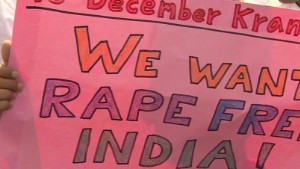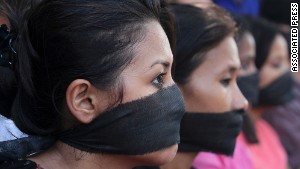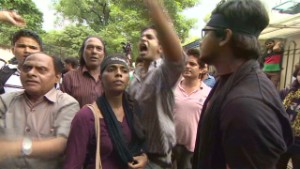September 11, 2013 -- Updated 2101 GMT (0501 HKT)
India's missing women
STORY HIGHLIGHTS
- Certain regions have less than 800 girls born for every 1,000 boys
- Parents circumvent rarely enforced laws like ban on sex-selected abortion and dowries
- Villages lack enough women for men to marry because of sex imbalance
Editor's note: Carl Gierstorfer is a journalist and filmmaker with a background in biology. He has produced and directed documentaries for German public broadcaster ZDF, Discovery Channel and the BBC. His work on violence against women in India was supported by the Pulitzer Center on Crisis Reporting.
His website is www.carlgierstorfer.com.
His website is www.carlgierstorfer.com.
(CNN) -- The New Delhi rape case left the whole world wondering why India is treating its women so badly. In fact, discrimination against women already starts in the womb: India has some of the most distorted sex-ratios in the world. There are regions where fewer than 800 girls are born for every 1,000 boys. For many reasons Indian culture prefers sons. An expensive bride-price, or dowry, is only one of them.

Carl Gierstorfer is a journalist and filmmaker, focusing on violence against women in India.
So day-by-day, thousands of parents circumvent rarely enforced laws and have their baby daughters aborted after an ultrasound scan has revealed the sex of the fetus. It is estimated that India has been losing up to 12 million baby girls over the last three decades.
I wanted to find out what it means for a society if such a significant number of women are missing.
In one village just two hours drive outside Delhi, I met Narinder, a schoolteacher, and his family. He had three brothers and only one of them got married. There weren't enough brides, because the village has been aborting their daughters for decades.




Narinder told me that he had already reached out to an agent who would find him a bride from afar. In fact, he planned to share this bride with his brothers.
I felt sorry for Narinder, because he totally understood that his misery was due to the fact that his village has been actively selecting for sons. Still, in a quiet moment, he confided to me, that if his purchased wife would be pregnant, he'd make sure it was a son. I was perplexed. Everyone in this village knew it was wrong to prefer sons over girls, everyone experienced the problems firsthand.
And still, like sleepwalkers, they continued their way, because culture dictates that sons are a blessing and daughters a curse.
After the Delhi rape case, the whole world looked at India in disbelief, its urban middle class took to the streets. I returned to India to meet Shafiq Khan, a former Maoist rebel, who realized that violence is not the way forward. Shafiq now uses his wit and bravery to make inroads into rural India's patriarchal societies.
We hit the dusty streets, down to Haryana where Shafiq introduced me to women who do not have a voice, women for whom nobody demonstrates. They are abused and raped and sold like cattle and nobody cares. They are called Paro, or strangers. They are the sort of women Narinder will buy -- those who make up for the scores who are never born.
Akhleema and Tasleema, two sisters from Kolkata, were born into a poor family, before her aunt sold them via an agent to two brothers in Haryana, who could not find a bride. Within weeks, Akhleema was beaten so hard by her husband, that she lost hearing in her left ear. Both spend their time cooking, cleaning and tending the fields. They have no rights, no voice and, most shockingly: there is no way back. They have children with their men and it is culturally unacceptable to leave them behind.
But where are all these trafficked women coming from? In a cruel paradox, it's the poor northeastern states of India, like West Bengal or Assam, where sex-ratios aren't that skewed, that make up for large parts of all the missing women.
Assam is beautiful, even during the dry season. The Brahmaputra winds its way through the plains, quietly and peacefully.
"But don't be mistaken", Shafiq says. Because during the rainy season, the river erupts over its banks, destroys fields and villages. In these already poverty-stricken regions, flooding takes away the little people have. Thousands of families are pushed into poverty and helplessness. They end up in flood shelters, vulnerable and easy prey for traffickers, like Saleha and her husband Husain. Their daughter Jaida went missing two years ago. They saw a man entering the hamlet and talking to Jaida. She vanished without a trace.
In a remote village on the dusty floodplains we meet Halida. She had just turned 14, when a man kidnapped her while fetching water. For two days he raped Halida, told her that he would bring her to Delhi in order to sell her. Halida could escape, but now she cannot go to school anymore, because all the children know of the rape and tease her. The parents, day-laborers, cannot find work anymore, because they are ostracized by the whole village. The rape destroyed the family.
While the trafficker may have lost his prey, it's unlikely that he will ever be punished. The police are corrupt and the more destruction there is, the easier it will be for him to find new victims.
Thus closes a vicious circle in which millions of India's women are trapped. The prejudices against women are so deeply engrained in the cultural fabric, that only a combined effort, old and young, urban and rural, will be able to break it once and for all.


No comments:
Post a Comment